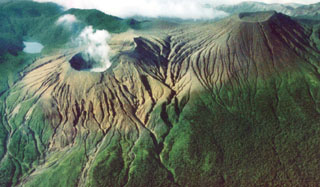Report on Rincon de la Vieja (Costa Rica) — 7 June-13 June 2023
Smithsonian Institution / US Geological Survey
Weekly Volcanic Activity Report, 7 June-13 June 2023
Managing Editor: Sally Sennert.
Please cite this report as:
Global Volcanism Program, 2023. Report on Rincon de la Vieja (Costa Rica) (Sennert, S, ed.). Weekly Volcanic Activity Report, 7 June-13 June 2023. Smithsonian Institution and US Geological Survey.
Rincon de la Vieja
Costa Rica
10.8314°N, 85.3364°W; summit elev. 1729 m
All times are local (unless otherwise noted)
OVSICORI-UNA reported that phreatic explosions continued at Rincón de la Vieja during 6-13 June, with multiple phreatic events recorded during 6-8 June. A 14-minute-long event that began at 0142 on 7 June was comprised of two pulses of gas-and-steam that rose 1 km above the crater rim. At 0942 on 8 June a plume of steam and gas rose 2.5 km above the crater rim, followed at 1810 by a moderate phreatic eruption that ejected lake water with sediment to less than 100 m above the crater rim and produced a white steam plume that rose 3 km and drifted W. Two events recorded at 0138 and 2037 on 9 June were similar in energy to the 8 June event at 1810. Gas emissions were visible on 10 June. Small phreatic events at 0357, 0521, and 0546 on 11 June produced white steam-and-gas plumes that drifted W. White steam-and-gas plumes from small phreatic events at 1031 and 1039 on 12 June rose as high as 1 km above the crater rim.
Geological Summary. Rincón de la Vieja is a volcanic complex in the Guanacaste Range of NW Costa Rica. Sometimes referred to as the Rincon de la Vieja-Santa María Volcanic Complex, it consists of a slightly arcuate 20-km-long ridge of 12 craters and pyroclastic cones constructed within the 15-km-wide early Pleistocene Guachipelín caldera, whose rim is exposed on the south side. Sometimes known as the "Colossus of Guanacaste," it has an estimated volume of 130 km3 and contains at least nine major eruptive centers. The Santa María cone, the highest peak of the complex, is located on the E side of the ridge and has a lake within the 400-m-diameter crater. A Plinian eruption producing the 0.25 km3 Río Blanca tephra about 3,500 years ago was the last major magmatic eruption. All subsequent eruptions, including numerous reported eruptions possibly dating back to the 16th century, have been from the active crater, near the center of the complex, with an acidic 300-m-diameter lake.
Source: Observatorio Vulcanologico y Sismologico de Costa Rica-Universidad Nacional (OVSICORI-UNA)

